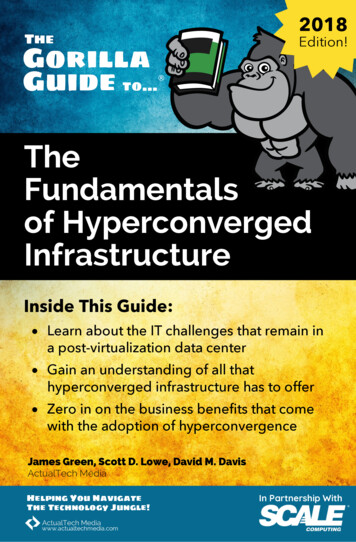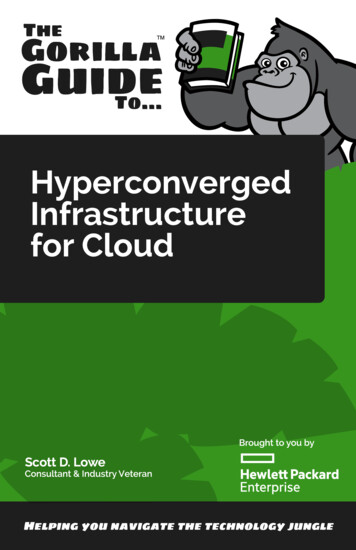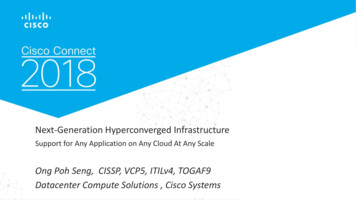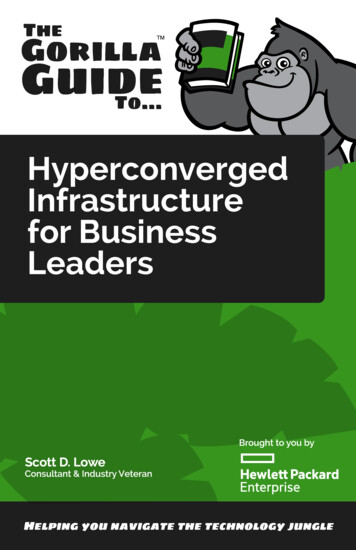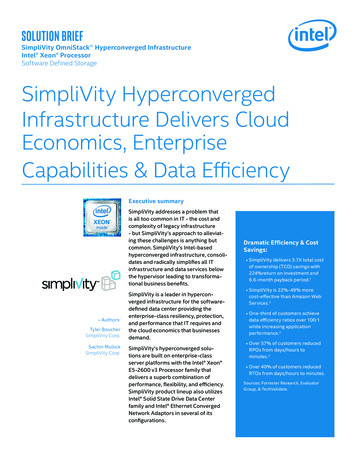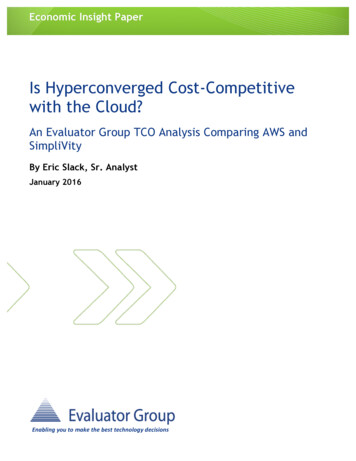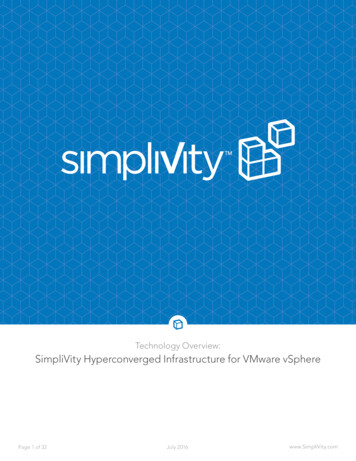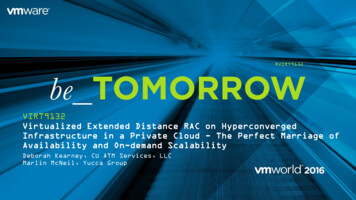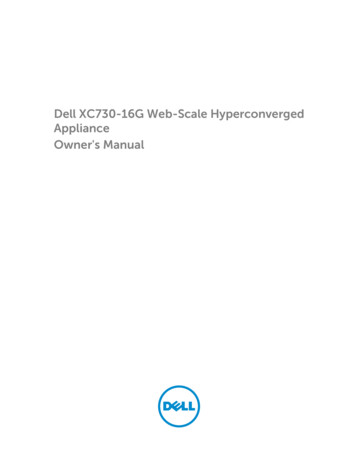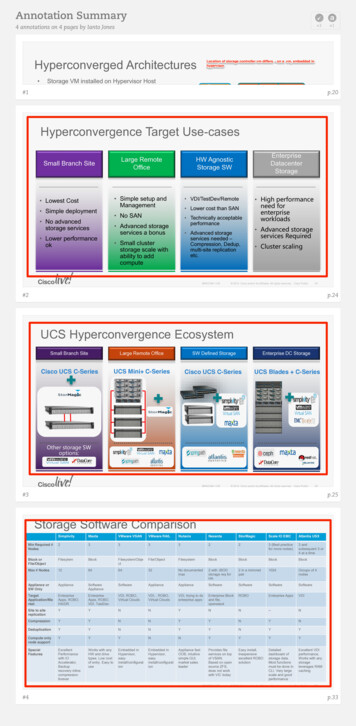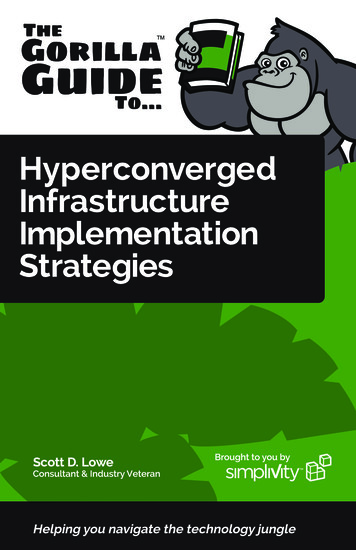
Transcription
TheGorilla Guide egiesScott D. Lowe David M. Davis
The Gorilla Guide to Hyperconverged InfrastructureImplementation StrategiesAuthor:Editors:Scott D. Lowe, ActualTech MediaDavid M. Davis, ActualTech MediaHilary Kerchner, Dream Write CreativeBook Design:Braeden Black, Avalon Media ProductionsGeordie Carswell, ActualTech MediaLayout:Braeden Black, Avalon Media ProductionsCopyright 2015 by ActualTech MediaAll rights reserved. This book or any portion there of may not be reproduced or usedin any manner whatsoever without the express written permission of the publisherexcept for the use of brief quotations in a book review.Printed in the United States of AmericaFirst Printing, 2015ISBN 978-1-943952-02-1ActualTech MediaOkatie Village Ste 103-157Bluffton, SC 29909www.actualtechmedia.com
Table of ContentsSection 1: Technical OverviewChapter 1: Introduction to Hyperconverged Infrastructure3Chapter 2: Architecting the Hyperconverged Data Center11Chapter 3: Addressing Data Center Metrics Pain Points23Chapter 4: Ensuring Availability, Data Protection andDisaster Recovery35Chapter 5: Hyperconvergence and the Public Cloud51Section 2: Use CasesChapter 6: Virtual Desktop Infrastructure67Chapter 7: Remote Office/Branch Office77Chapter 8: Tier 1/Dedicated Application Support85Chapter 9: Data Center Consolidation89Chapter 10: Test and Development Environments95Chapter 11: Aligning Architecture and Priorities103Section 3: Organizational ConsiderationsChapter 12: Overcoming Inertia: MitigatingHyperconvergence Perceived Challenges111Chapter 13: Hyperconvergence Economics:How It Impacts the IT Budget119iii
About the AuthorScott D. Lowe, vExpertScott Lowe is a vExpert and partner andCo-Founder of ActualTech Media. Scotthas been in the IT field for close to twentyyears and spent ten of those years in fillingthe CIO role for various organizations. Scotthas written thousands of articles and blogpostings and regularly contributes towww.EnterpriseStorageGuide.com &www.ActualTech.io.About the EditorDavid M. Davis, vExpertDavid Davis is a partner and co-founder ofActualTech Media. With over 20 years inenterprise technology, he has served as anIT Manager and has authored hundreds ofpapers, ebooks, and video training courses.He’s a 6 x vExpert, VCP, VCAP, & CCIE#9369. You’ll find his vSphere video trainingat www.Pluralsight.com and he blogs atwww.VirtualizationSoftware.com and www.ActualTech.io.iv
About ActualTech MediaActualTech Media provides enterprise IT decision makers with theinformation they need to make informed, strategic decisions as theymodernize and optimize their IT operations.Leading 3rd party IT industry influencers Scott D. Lowe, David M.Davis and special technical partners cover hot topics from the software-defined data center to hyperconvergence and virtualization.Cutting through the hype, noise and claims around new data centertechnologies isn’t easy, but ActualTech Media helps find the signal inthe noise. Analysis, authorship and events produced by ActualTechMedia provide an essential piece of the technology evaluation puzzle.More information available at www.actualtechmedia.comv
About SimpliVitySimpliVity hyperconverged infrastructure delivers the enterprise-classperformance and availability today’s IT leaders require, with the cloudeconomics businesses demand. No other company has taken on themega task of assimilating all IT elements below the hypervisor intox86 building blocks that combine to create a single, scalable resourcepool. SimpliVity’s unique data architecture improves performanceand data efficiency, and enables built-in data protection and globalunified management from a single management interface. SimpliVity’shyperconverged infrastructure simplifies IT infrastructure, reducingCapEx; accelerates deployment and streamlines operations, saving runrate expenses; and improves recovery objectives, minimizing risk—allcontributing to a three-fold TCO savings.Visit www.Simplivity.comvi
Gorilla Guide FeaturesIn the BookThese help point readers to other places in the book where aconcept is explored in more depth.The How-To CornerThese will help you master the specific tasks that it takes to beproficient in the technology jungle.Food For ThoughtIn the these sections, readers are served tasty morsels ofimportant information to help you expand your thinking .School HouseThis is a special place where readers can learn a bit moreabout ancillary topics presented in the book.Bright IdeaWhen we have a great thought, we express them through aseries of grunts in the Bright Idea section.Dive DeepTakes readers into the deep, dark depths of a particular topic.Executive CornerDiscusses items of strategic interest to business leaders.vii
Section 1Technical Overview
1Introduction toHyperconvergedInfrastructureIn recent years, it seems like technology is changing faster than it usedto in decades past. As employees devour newer technologies such assmartphones, tablets, wearables, and other devices, and as they becomemore comfortable with solutions such as Dropbox and Skype, theirdemands on enterprise IT intensify. Plus, management and otherdecision makers are also increasing their demands on enterprise IT toprovide more infrastructure with less cost and time. Unfortunately,enterprise IT organizations often don’t see much, if any, associatedincreases in funding to accomodate these demands.These demands have resulted in the need for IT organizations toattempt to mimic NASA’s much-heralded “Faster, Better, Cheaper”operational campaign. As the name suggests, NASA made greatattempts to build new missions far more quickly than was possible inthe past, with greater levels of success, and with costs that were dramatically lower than previous missions. NASA was largely successfulin their efforts, but the new missions tended to look very differentfrom the ones in the past. For example, the early missions were big and
complicated with a ton of moving parts, while modern missions havebeen much smaller in scale with far more focused mission deliverables.What is NASA?NASA is the United States National Aeronautical and SpaceAdministration and has been responsible for helping the U.S.achieve success in its space programs, from the moon landingto recent high quality photographs of Pluto. NASA has facedserious budget cuts in recent years, but has been able to retoolitself around smaller, more focused missions that cost less andhave achieved incredible results.The same “faster, better, cheaper” challenge is hitting enterprise IT,although even the hardest working IT pros don’t usually have to makerobots rove the surface of an inhospitable planet! Today’s IT departments must meet a growing list of business needs while, at the sametime, appeasing the decision makers who demand far more positiveeconomic outcomes (either by cutting costs overall or doing more workwithin the existing budget).Unfortunately, most of today’s data center architectures activelywork against these goals, because with increasing complexity comesincreased costs — and things have definitely become more complex.Virtualization has been a fantastic opportunity for companies, butwith virtualization has come some new challenges, including majorissues with storage. With virtualization, enterprise IT has movedfrom physical servers, where storage services could be configured ona per-server basis, to shared storage systems. These shared storagesystems, while offering plenty of capacity, have often not been ableto keep up in terms of performance, forcing IT departments to takecorrective actions that don’t always align with good economic practices.Introduction to Hyperconverged Infrastructure3
For example, it’s common for IT pros to add entire shelves of disks, notbecause they need the capacity, but because they need the spindles toincrease overall storage performance. There are, of course, other waysto combat storage performance issues, such as through the use of solidstate disk (SSD) caching systems, but these also add complexity to whatis already a complex situation.There are other challenges that administrators of legacy data centersneed to consider as well: Hardware sprawl. Data centers are littered with separate infrastructure silos that are all painstakingly cobbled together toform a complete solution. This hardware sprawl results in a datacenter that is increasingly complex, decreasing flexibility, andexpensive to maintain. Policy sprawl. The more variety of solutions in the data center,the more touch points that exist when it comes to applying consistent policies across all workloads. Scaling challenges. Predictability is becoming really important.That is, being able to predict ongoing budgetary costs and howwell a solution will perform after purchase are important. Legacyinfrastructure and its lack of inherent feature-like scaling capability make both predictability metrics very difficult to achieve. Desire for less technical overhead. Businesses want analysts andemployees that can help drive top line revenue growth. Purely technical staff are often considered expenses that must beminimized. Businesses today are looking for ways to make theIT function easier to manage overall so that they can redeploytechnical personnel to more business-facing needs. Legacy datacenters are a major hurdle in this transition.So, with all of this in mind, what are you to do?4Chapter 1
Hyperconverged Infrastructure from30,000 FeetAn emerging data center architectural option, dubbed hyperconvergedinfrastructure, is a new way to reduce your costs and better alignenterprise IT with business needs. At its most basic, hyperconvergedinfrastructure is the conglomeration of the servers and storage devicesthat comprise the data center. These systems are wrapped in comprehensive and easy-to-use management tools designed to help shield theadministrator from much of the underlying architectural complexity.Why are these two resources, storage and compute, at the core ofhyperconverged infrastructure? Simply put, storage has becomean incredible challenge for many companies. It’s one of— if notthe — most expensive resources in the data center and often requires ahighly skilled person or team to keep it running. Moreover, for manycompanies, it’s a single point of failure. When storage fails, swaths ofservices are negatively impacted.Combining storage with compute is in many ways a return to the past,but this time many new technologies have been wrapped around it.Before virtualization and before SANs, many companies ran physicalservers with directly attached storage systems, and they tailored thesestorage systems to meet the unique needs for whatever applicationsmight have been running on the physical servers. The problem withthis approach was it created numerous “islands” of storage and compute resources. Virtualization solved this resource-sharing problem butintroduced its own problems previously described.Hyperconverged infrastructure distributes the storage resource amongthe various nodes that comprise a cluster. Often built using commodityserver chasses and hardware, hyperconverged infrastructure nodes andappliances are bound together via Ethernet and a powerful softwareIntroduction to Hyperconverged Infrastructure5
layer. The software layer often includes a virtual storage appliance(VSA) that runs on each cluster node. Each VSA then communicateswith all of the other VSAs in the cluster over an Ethernet link, thusforming a distributed file system across which virtual machines are run.VM VM VMVSAVM VM VMVSAVM VM VMVSAShared Storage Pool / Storage NamespaceHypervisorHypervisorHypervisorFigure 1-1: An overview of a Virtual Storage ApplianceThe fact that these systems leverage commodity hardware is critical.The power behind hyperconverged infrastructure lies in its ability tocoral resources – RAM, compute, and data storage – from hardwarethat doesn’t all have to be custom-engineered. This is the basis forhyperconverged infrastructure’s ability to scale granularly and thebeginnings of cost reduction processes.The basics behind hyperconverged infrastructure should bewell understood before proceeding with the remainder ofthis book. If you’re new to hyperconverged infrastructure orare unfamiliar with the basics, please read HyperconvergedInfrastructure for Dummies, available now for free fromwww.hyperconverged.org.6Chapter 1
Resources to ConsolidateThe basic combination of storage and servers is a good start, but onceone looks beyond the confines of this baseline definition, hyperconverged infrastructure begins to reveal its true power. The morehardware devices and software systems that can be collapsed into ahyperconverged solution, the easier it becomes to manage the solutionand the less expensive it becomes to operate.Here are some data center elements that can be integrated in a hyperconverged infrastructure.Deduplication AppliancesIn order to achieve the most storage capacity, deduplicationtechnologies are common in today’s data center. Dedicated appliances are now available which handle complex and CPU-intensivededuplication tasks, ultimately reducing the amount of data thathas to be housed on primary storage. Deduplication services arealso included with storage arrays in many cases. However, deduplication in both cases is not as comprehensive as it could be. As datamoves around the organization, data is rehydrated into its originalform and may or may not be reduced via deduplication as it movesbetween services.SSD Caches/All-Flash ArrayTo address storage performance issues, companies sometimesdeploy either solid state disk (SSD)-based caching systems or fullSSD/flash-based storage arrays. However, both solutions have thepotential to increase complexity as well as cost. When server-sidePCI-e SSD cards are deployed, there also has to be a third-partysoftware layer that allows them to act as a cache, if that is the desire.Wi
At its most basic, hyperconverged infrastructure is the conglomeration of the servers and storage devices that comprise the data center. These systems are wrapped in compre- hensive and easy-to-use management tools designed to help shield the administrator
